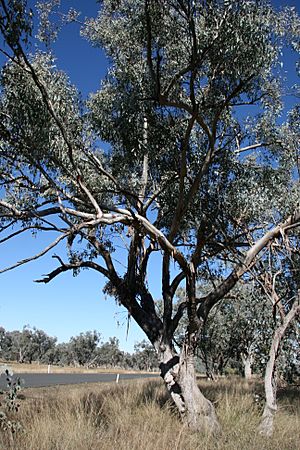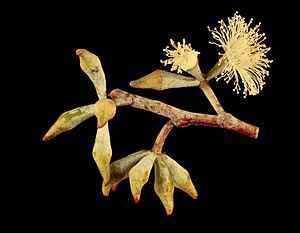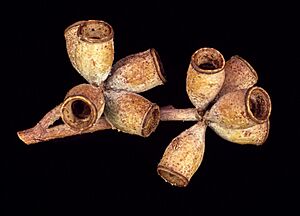White box
Quick facts for kids White box |
|
|---|---|
 |
|
| Eucalytpus albens habit | |
| Scientific classification | |
| Genus: |
Eucalyptus
|
| Species: |
albens
|
| Synonyms | |
|
|
The white box (scientific name: Eucalyptus albens) is a common tree. You can find it on the western slopes and plains of New South Wales. It also grows in nearby parts of Queensland and Victoria.
This tree has rough, stringy bark at the bottom of its trunk. Higher up, the bark is smooth and white. Its leaves are shaped like a spear. The tree's flower buds grow in groups of seven. They are shaped like spindles and appear near the leaves or at the end of branches. White flowers usually bloom from August to February. The fruits look like small barrels or urns.
Contents
What Does the White Box Tree Look Like?
The Eucalyptus albens is a tree that can grow quite tall. It reaches a height of 15–25 metres (49–82 ft) (about 50 to 80 feet). It has a straight trunk for about half its height. The top of the tree has many branches that spread out.
The trunk can be as wide as 0.5 metres (1 ft 8 in) (about 1.6 feet) across. Its bark is rough and stringy. It's usually pale grey and sometimes looks like a puzzle with many small pieces. This rough bark covers the trunk up to its larger branches. Higher up, the bark is smooth and white. It peels off in short strips every year.
Young white box plants have leaves that grow one after another. These leaves are egg-shaped or almost round. They are bluish-grey and measure 90–150 mm (4–6 in) long and 60–115 mm (2–5 in) wide. They also have a small stem called a petiole.
Adult leaves are shaped like a spear. They are a dull greyish-green color. One side is lighter than the other. These leaves are 100–160 mm (4–6 in) long and 17–30 mm (0.7–1 in) wide. Their petioles are 15–22 mm (0.6–0.9 in) long.
The flower buds grow in groups of seven on a branching stem. This stem is flattened or has angles. It is 10–18 mm (0.4–0.7 in) long. Each flower sits on a small, round stem called a pedicel, which is up to 5 mm (0.2 in) long.
The buds are shaped like spindles or cylinders. They are 10–18 mm (0.4–0.7 in) long and 4–7 mm (0.2–0.3 in) wide. The cap of the bud, called the operculum, is cone-shaped. It is about as long as the base of the flower. The flowers are white and usually appear in autumn, from March to May. The fruits are shaped like urns or barrels. They are 6–14 mm (0.2–0.6 in) long and 5–10 mm (0.2–0.4 in) wide.
How the White Box Got Its Name
The Eucalyptus albens was first officially described in 1867. A scientist named George Bentham gave it its formal description. He used samples collected from different places, including by Allan Cunningham near the Macquarie River.
This tree is related to other "box" trees. These include the grey box (E. moluccana) and the inland grey box (E. microcarpa). Sometimes, the white box can even mix with the grey box. This creates a new type of tree in places like the Hunter Valley.
The second part of its scientific name, albens, is a Latin word. It means "whitening." Both this name and the common name "white box" come from the white dust that can be seen on the leaves and gumnuts. The word "box" in its name comes from the square, puzzle-like pattern of its bark.
Where Does the White Box Tree Grow?
The white box tree is found in woodlands with lots of grass and eucalypt trees. It grows on flat areas or gentle slopes. You can find it from south-east Queensland, across the western slopes of New South Wales, and into north-eastern Victoria. It reaches as far south as Yea. Some smaller groups of these trees also grow in the Flinders Ranges and near Melrose in South Australia.
The white box often grows alongside other trees. These include the inland grey box, fuzzy box (E. conica), yellow box (E. melliodora), and Pilliga grey box (E. pilligaensis). You might also see it with red ironbark (E. sideroxylon), narrow-leaved ironbark (E. crebra), and Blakely's red gum (E. blakelyi). Other common neighbors are apple species (Angophora), black cypress (Callitris endlicheri), white cypress (Callitris glaucophylla), kurrajong (Brachychiton populneus), and different kinds of wattles (Acacia).
Is the White Box Tree Protected?
Yes, the white box tree is part of a special forest type. This forest is called "WhiteBox Yellow Box Blakelys' Red Gum Woodland." It's often just called "Box-Gum Woodland." This type of woodland is in serious trouble.
The Australian Government has listed it as "critically endangered." This means it's at a very high risk of disappearing. This protection comes from the Environment Protection and Biodiversity Conservation Act 1999. The New South Wales Government also calls it an "endangered ecological community." This is under their Biodiversity Conservation Act 2016.
What is the White Box Tree Used For?
The wood from the white box tree is very heavy and hard. Because of this, it's often used for things that need to be strong. For example, it's used to make railway sleepers (the wooden beams under train tracks). It's also used for fence posts.
Besides its wood, the flowers of the white box tree are very important. They produce a sweet liquid called nectar. Bees collect this nectar to make honey. This makes the white box tree valuable for the honey industry.
See also
 In Spanish: Eucalyptus albens para niños
In Spanish: Eucalyptus albens para niños



